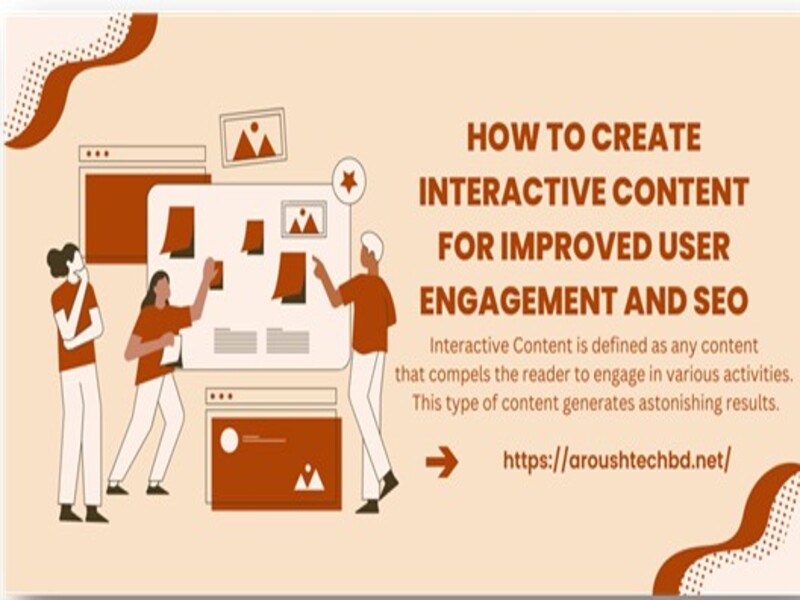Interactive Content is any content that compels the reader to engage in various activities. This type of content generates astonishing results. According to a source online, 81% of marketers agree that interactive content is much more efficient in grabbing a reader’s attention than static content.
It is an excellent alternative to passive content or a better replacement. Interactive content can help you educate your audience with the help of vibrant visuals and other forms of participation. Most people are fascinated by such content and prefer it over large pieces of plain text.
Interactive Content is gradually becoming the next big form of content writing, and that’s the reason why you should make such content. Moreover, it has Interactive Content, which is a huge plus point.
Since so many perks of interactive content have already been discussed, you might be wondering how to create it. We have made a list of steps that you can follow to make interactive content that will improve your user engagement and SEO.
1. Use Easy to Understand Wording
The majority of people online have extremely short attention spans. They are very likely to skip an article with high-standard vocabulary or unreadable sentences. To get a reader to stay on your site and consume your content, you have to make use of simple words while providing information.
You can use this type of wording by following the standard grammar conventions and using simpler words. This might seem like a difficult task, and to some extent, it is. If you have a hard time writing simple and grammatically accurate content, you can use online tools that assist you by paraphrasing your work into a much more readable form.
These tools work by paraphrasing sentences by shuffling sentence components and replacing words with relevant synonyms while preserving the actual meaning of the sentence.
2. Make Proper Use of Headings
Proper and relevant headings and subheadings impact your content by large. They inform the user and the search engine about your work’s outline or main points. Similarly, it lets the search engine decide whether your work is related to a particular search or query. So, it is clear that headings are a potential source of traffic.
As far as the user experience is concerned, the proper use of headings has a positive impact. It makes your work look organized, and navigation becomes a lot easier. Users are more likely to explore your work if it is properly formatted.
No one wants to read a messy article with no outline whatsoever. That’s because often, people are looking to know about only a small segment of your article. That’s why they want to skip to that segment and not read the whole article. So, creating proper headings and subheadings can enhance the experience of such users.
3. Make Use of Calls to Action
The key to making interactive content is to use a guiding tone throughout your writing. You have to tell your users what to do. This phenomenon of encouraging a reader to perform a particular task is known as a Call to action (CTA). Well, optimize the call to action.
A basic example of a CTA could be something like “Click Here” or “Download Now.” Using such calls to action in your content makes it much more engaging, and usually, the users appreciate the guidance.
Alternatively, it can result in users spending more time on your site. You can achieve your goal of increased user engagement simply by incorporating a few calls to action into your work. But be cautious about not overusing this trick. There are chances you might exhaust your audience by adding excessive tasks for them to complete. Remember, the main goal is to add an element of fun to your work.
4. Adjust Keywords Naturally
This step is essential for both interactive and non-interactive content. The use of keywords in your content should never seem forced. Try to use the keyword in such a flow that it doesn’t stand out. Similarly, don’t overuse these keywords, thinking it will improve your site’s SEO.
Determining which keywords will provide the best results for you could be tricky. This requires proper research and insight into your target audience’s requirements and searches. However, you can get assistance from a few online tools in this regard, such as Google Keyword Planner or SEMrush.
Keywords don’t necessarily make your content more interactive, but they will help you reach your target audience. Hence, you have to adjust these keywords in your content so that your ranking in the search results improves and your presence among the target audience increases.
5. Create Content that Suits Your Audience
Make sure not to get tangled up too much in the technical aspect of writing content that you start making it irrelevant. Your content should be according to your audience’s needs. Research the keywords that help users reach your content and try to engage with them based on that information.
Write about any possible question a reader might have. Provide valuable information based on facts and figures and not just ordinary chunks of text that are of no use to anyone. Support your claims by citing trusted sources on the web. Moreover, you can interlink your website’s pages and compel users to look at them.
Another way to create content for a specific target audience is to know their location. For example, if for a particular keyword, the majority of traffic is coming from one location, you can optimize your content to match the preferences of users from that specific location.
6. Use Infographics in Your Content
An infographic is a visual that provides an overview of what you have written in your content. According to an online source,60% of businesses have used infographics as a part of their content strategy.
Using these infographics can make your content more engaging and understandable. Some users might even skip all the written content and only use infographics to understand the topic. Hence, you should create attractive visuals that explain a written form of text using images.
This strategy has helped countless businesses around the world and is still being used as a valuable asset by multiple companies online. It is safe to say that incorporating infographics into your content will add to its worth and generate higher traffic and user engagement.
7. Optimize Your Images
Images should also be a part of your content, but there are a few steps you should take before adding an image to your content. A few of them are discussed here:
- Use clear names for an image file. If relevant, you can also add a keyword to the name of your image.
- Resize your images to fit in all types of screens because your traffic probably comes from different devices.
- Be careful while choosing the dimensions of your image so that it perfectly fits in the desired location.
- Try not to use very high-quality images because they can cause higher loading times and negatively impact user experience.
If you skip these steps, the use of images in your content may backfire by either disrupting the smooth user experience or confusing a search engine about the relevancy of your content.
8. Conduct Regular Quizzes or Polls
A quiz or a poll is a very effective source for interacting with your audience. For example, a quiz can help users calculate their knowledge of the topic. Alternatively, a poll can let users express their opinions on a certain matter.
You can either incorporate such quizzes and polls as part of your content or conduct them regularly on your website, social media, emails, etc. This will make the users feel involved, and they might become regular readers of your content.
Both of these activities are useful because they take up only a short time to complete, and both the user and the writer benefit from them.
Conclusion
Interactive content is a very advantageous medium in terms of consistent traffic. The tips in the article will help you create such interactive content. Additionally, following these tips will help you improve your SEO and audience engagement.

